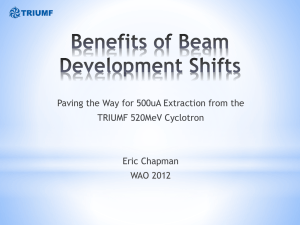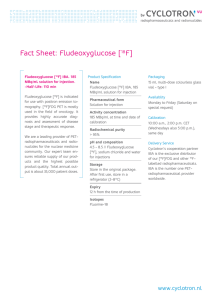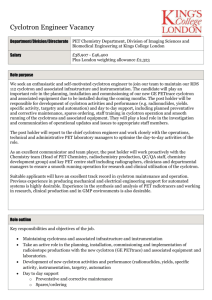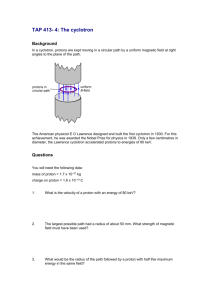Cyclotrons Chapter 4 - Indico
advertisement
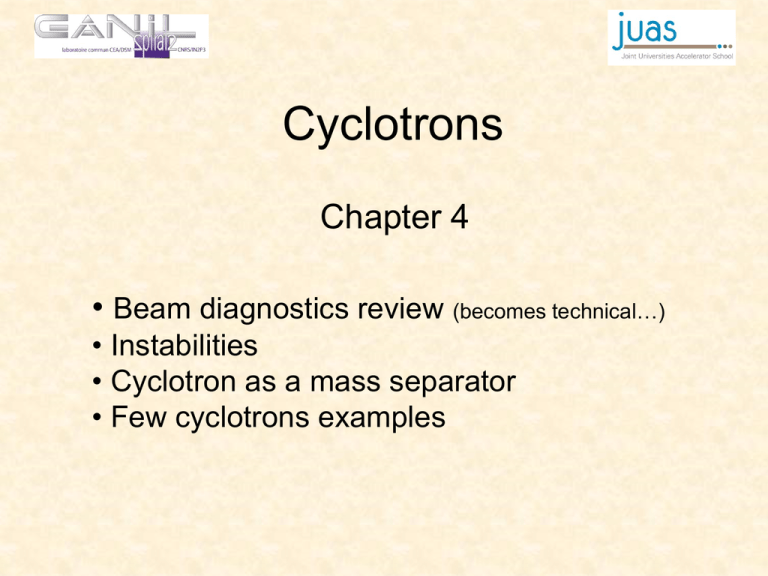
Cyclotrons Chapter 4 • Beam diagnostics review (becomes technical…) • Instabilities • Cyclotron as a mass separator • Few cyclotrons examples Beam properties compact cyclotrons) - current of full beam - little space (particularly compact cyclotrons) - transverse position of full beam compact monitors, no radiation shielding, nearby - phase of bunch center activated components,RF nearby - transverse profile – projection 2D usage - transverse emittance - 1D-2D - for machine safety - longitudinal profile - permanently - longitudinal emittance - for tuning -beam ion energy distribution - at setup Monitor properties - for error search - resolution - only at commissioning - temporal resolution / rate - destructive vs. non-destructive (loss of beam up time, machine activation) familiar monitors - low current limit (sensitivity, noise) -beam position monitor (BPM capacitive or -high current limit (thermal damage, outgassing/sputtering) - life time (radiation damage/hardness) -reliability, cost, .... Special „cyclotron environment“ for monitors, drives, cooling -high magnetic field / stray field (particularly - current transformer (DCCT, ACCT), Faraday-cup inductive coupling) - phase probe (capacitive coupling) - wire monitor, wire grid - screen - emittance measurement device (slit-slit/slitgrid/Allison/3 profile/Q-pole variation) pepperpot 2 High intensity diagnostics MSU K1200 Deflector Septum (Tungsten) Beam induced defects with a 160 kW beam at PSI Beam Diagnostics 4 Current measurement (non interceptive) & ( > nAe ) Current Transformers Electronic Devices Beam amplifier Alimentation gain 105 box detection » gain 100 board V « amplitude Voutput t t t The beam is « chopped » at a low frequency (hundred of Hz) to use this kind of diagnostics. Current transformer signal is amplify and measure by « amplitude detection board ». I [A] = Npps x Q x e e = 1.6 10-19 C 5 Current measurement (non interceptive) By Current Transformers (ACCT) Beam Current transformer with shielding 6 Current measurement (interceptive) 6kW cooled By Faraday Cups Faraday cup Beam cooling Beam Magnet for secondary emissions 7 Current measurement: Radial probe 8 Current measurement : Beam monitoring Beam 9 Phase measurement: Isochronism Beam Phase / RF phase Radius radius + Phasemeter Cavity RF frequency X Y DP 10 Phase measurement: Isochronism 11 Beam Profiler: secondary emission current 12 Profiler : wire scanner Tungsten wire Beam Wire in vertical position Beam Wire in horizontal position 13 Beam position monitor top bottom Beam Beam 14 Low intensity diagnostics < 109 pps Gas Profiler 16 Gaz Profiler 17 From Physics diagnostics 18 Back to dynamics and instabilities 19 Resonances During the acceleration, The plot of nr and nz change because nr,z B(r) nr vs nz is called the working point diagram. Like any oscillatory phenomenon, the amplitude of a betatronic motion can grow uncontrolled whenever an external source excites it with its own frequency. This resonance occurs as the betatronic frequency is a multiple of the "geometrical frequency" of the cyclotron. In this case, any kick given to the particle because of its particular position will be experienced again and again. These are known as systematic resonances Under proper circumstances and frequency ratios, the 2 oscillators can be coupled and the energy stored in one motion, transferred to the other. These are coupling resonances (K.nr + L.nz = P). The particle’s working point curve should avoid or cross as fast as possible those lines. 20 Systematic resonances Working point curve Coupling resonances 21 Tunes and resonances K.nr + L.nz = P • K, L and P integer • |K| + |L| is called the resonance order (1, 2, 3 …) W r² 22 Cyclotron as a separator Q0 B ( r ) m0 Constant energy gain per turn: T QV0 cos( ) For an isochronous ion (Q0, m0): rev For ions with a Q/m different from the isochronous beam Q0/m0, ≠ rev There is a phase shift of this ion compared to the RF field during acceleration 1 (m / Q) 2Nh 2 m0 / Q0 when the phase reaches 90°, the beam is decelerated and lost. 23 Cyclotron resolution There is the possibility to have out of the source not only the desired ion beam (m0,Q0) but also beams with close Q/m ratio. If the mass resolution of the cyclotron is not enough, both beams will be accelerated, extracted and sent to the physics experiments. Mass resolution: m Q 1 R m 2 h N 0 Q 0 CIME example: h=3, N = 300 We want R small separation of close ions R~ 10-4 Meaning that ions with a m/Q > 1.0001×m0/Q0 will not be extracted To have R small for a given harmonic h, the number of turn N needs to be increased lowering the accelerating voltage small turn separation poor injection and/ or extraction (great problems for new exotics beam machines : isobar and contamination for new machine…) 24 Cyclotron as a separator 2Nh 1 (m / Q) 2 m0 / Q0 Q/m ~ 3/18 ~ 6/36 m0=36 and Q=6 90° m=18 and Q=3 25 Few cyclotrons 26 The beginning The 11-inch cyclotron and lab bench equipment. 1933 : Livingston (left) and Lawrence with the 27-inch (later 37-inch) cyclotron. 27 Argonne 60 inches cyclotron (deutons 21,6 MeV deuton beam out of an aluminium foil) 28 Karlsruhe cyclotron. 29 CYCLONE 30 (IBA) : H- 15 à 30 MeV primarily designed for industrial and medical applications 30 Cyclone 10/5 cyclone 3D 31 Cyclotron laboratories 32 33 Separated-Sector Cyclotron Facility SSC Polarized ion source SPC2 SPC1 ECR ion source Target vaults electronics Spectrometer electronics Radioisotope production beam swinger Proton therapy Neutron therapy 0 10 20 m 34 Michigan State University Cyclotrons+A1900+Experimental Areas 35 36 870 keV Cokcroft-Walton preacc 72 MeV injector 2 590 MeV Ring cyclotron Variable energy injector 1 37 38 ion energies range between 8 and 100 A MeV in harmonic mode h=2 bending limit Kb=800 and by the focusing limit Kf=200. 39 40 41 520 MeV proton, Triumf, Canada The diameter of the machine is about 18 m Lower half of the Main Magnet poles 42 • • • • • • • • • • • • • • • • • • • • • • • • • • • • • • BIBLIOGRAPHY Textbooks S. Humphries, jr., J. Wiley & Sons 1986, Principles of Charged Particle Acceleration. H. Bruck, Bibl. des Scienc. Et Tech. Nucléaires 1966, Accélérateurs Circulaires de Particules. J. J. Livingood, D. van Nostrand Comp. 1961, Principles of Cyclic Particle Accelerators. Conference Proceeding Proceedings of the International Conferences on Sector-focused Cyclotrons and on Cyclotrons and their application : ICC1, Informal Conference on sector-focused Cyclotrons 1959 in Sea Island, NAS-NRC, Publ.656 (1959) ICC2, Int. Conference 1962 in Los Angeles, Nucl. Inst.& Meth. 18, 19 (1962) ICC3, Int. Conference 1963 in Geneva, CERN 63-19 (1963) ICC4, Int. Conference 1966 in Gatlinburg, IEEE Trans. NS-13(4) (1966) ICC5, 5th Int. Cyclotron Conference 1969 in Oxford, McIllroy, Butterworth (1971) ICC6, 6th Int. Cyclotron Conference 1972 in Vancouver, AIP Conf. Proc. N°9 (1972) ICC7, 7th Int. Cyclotron Conference 1975 in Zürich, Birkhäuser (1975) ICC8, 8th Int. Cyclotron Conference 1978 in Bloomington, IEEE Trans. NS-26(2) (1979) ICC9, 9th Int. Cyclotron Conference 1981 in Caen, les Editions de Physique (1982) ICC10, 10th Int. Cyclotron Conference 1984 in East Lansing, IEEE, New York (1984) ICC11, 11th Int. Cyclotron Conference 1986 in Tokyo, Ionics Publishing Tokyo (1987) ICC12, 12th Int. Cyclotron Conference 1989 in Berlin, World Scientific Publ. (1991) ICC13, 13th Int. Cyclotron Conference 1992 in Vancouver, World Scientific Publ. (1993) ICC14, 14th Int. Cyclotron Conference 1995 in Cape Town, World Scientific Publ Co. (1996) ICC15, 15th Int. Cyclotron Conference 1998 in Caen, Institute of Physics Publ. (1999) ICC16, 16th Int. Cyclotron Conference 2001 in East Lansing, American Inst. of Ph., New York (2001) Contribution to CERN Accelerator Schools W. Joho, CAS Aarhus 1986, CERN 87-10 (1987) 1 “Modern Trends in Cyclotrons” H.L. Hagedoorn et al., CAS Jülich 1990, CERN 91-04 (1991) 323 “Introduction to Cyclotron” H.L. Hagedoorn et al., CAS Leewenhorst 1991, CERN 92-01 (1992) 1 “Hamilton Theroy” P. Heikinnen, CAS Jyväskylä 1992, CERN 94-01 (1994) “Cyclotrons“ and “Injection and Extraction“ T. Stammbach, CAS La Hulpe, 1994, CERN 96-02 (1996) “Introduction to Cyclotrons“ F. Chautard, CAS Zeegse, CERN-2006-012 (2005) “Beam dynamics for cyclotrons” 43 END 44 The Cyclotron as seen by the Inventor 45 The Cyclotron as seen in the usual text book 46 The Cyclotron as seen by the Theorist 47 The Cyclotron as seen by the Operator 48 The Cyclotron as seen by the Visitor 49 The Cyclotron as seen by the Experimentalist 50 The Cyclotron as seen by the Student 51
